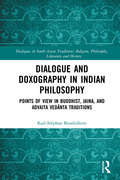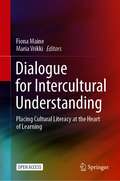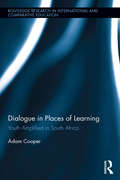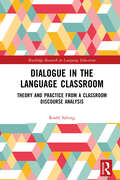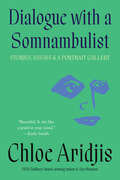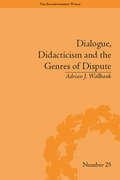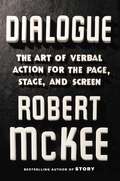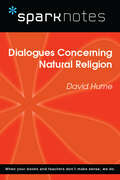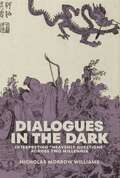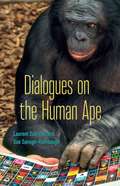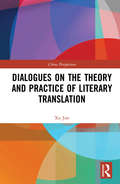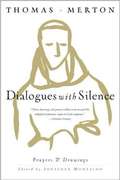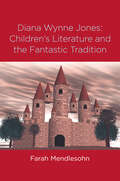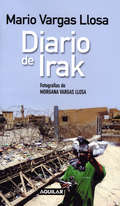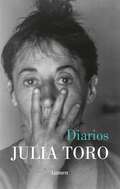- Table View
- List View
Dialogue and Doxography in Indian Philosophy: Points of View in Buddhist, Jaina, and Advaita Vedānta Traditions (Dialogues in South Asian Traditions: Religion, Philosophy, Literature and History)
by Karl-Stéphan BouthilletteThis is the first book fully dedicated to Indian philosophical doxography. It examines the function such dialectical texts were intended to serve in the intellectual and religious life of their public. It looks at Indian doxography both as a witness of inter- and intra-sectarian dialogues and as a religious phenomenon. It argues that doxographies represent dialectical exercises, indicative of a peculiar religious attitude to plurality, and locate these ‘exercises’ within a known form of ‘yoga’ dedicated to the cultivation of ‘knowledge’ or ‘gnosis’ (jñāna). Concretely, the book presents a critical examination of three Sanskrit doxographies: the Madhyamakahṛdayakārikā of the Buddhist Bhāviveka, the Ṣaḍdarśanasamuccaya of the Jain Haribhadra, and the Sarvasiddhāntasaṅgraha attributed to the Advaitin Śaṅkara, focusing on each of their respective presentation of the Mīmāṃsā view. It is the first time that the genre of doxography is considered beyond its literary format to ponder its performative dimension, as a spiritual exercise. Theoretically broad, the book reaches out to academics in religious studies, Indian philosophy, Indology, and classical studies.
Dialogue for Intercultural Understanding: Placing Cultural Literacy at the Heart of Learning
by Fiona Maine Maria VrikkiThis open access book is a result of an extensive, ambitious and wide-ranging pan-European project focusing on the development of children and young people’s cultural literacy and what it means to be European in the 21st century prioritising intercultural dialogue and mutual understanding. The Horizon 2020 funded, 3-year DIalogue and Argumentation for cultural Literacy Learning (DIALLS) project included ten partners from countries in and around Europe with the aim to centralise co-constructive dialogue as a main cultural literacy value and to promote tolerance, empathy and inclusion. This is achieved through teaching children in schools from a young age to engage together in discussions where they may have differing viewpoints or perspectives, to enable a growing awareness of their own cultural identities, and those of others. Central to the project is children’s engagement with wordless picture books and films, which are used as stimuli for discussions around core cultural themes such as social responsibility, living together and sustainable development. In order to enable intercultural dialogue in action, the project developed an online platform as a tool for engagement across classes, and which this book elaborates on.The book explores themes underpinning this unique interdisciplinary project, drawing together scholars from cultural studies, civics education and linguistics, psychologists, socio-cultural literacy researchers, teacher educators and digital learning experts. Each chapter of the book explores a theme that is common to the project, and celebrates its interdisciplinarity by exploring these themes through different lenses.
Dialogue in Places of Learning: Youth Amplified in South Africa (Routledge Research in International and Comparative Education)
by Adam CooperShowing how youth from one of the poorest and most violent neighborhoods in Cape Town, South Africa, learn differently in three educational contexts— in classrooms, in a community hip hop crew, on a youth radio show—this book illuminates how South African schools, like schools elsewhere, subtly reproduce inequalities by sorting students into social hierarchies linked to assessments of their use of language. Highlighting the voices and perspectives of young South Africans, this case study of youth in the global South explores how language is linked to cultural mixing which occurred during colonialism and slavery and continues through patterns of global mobility. Dialogue in Places of Learning: Youth Amplified in South Africa demonstrates how language and learning are bound to space and place.
Dialogue in the Digital Age: Why it Matters How We Read and What We Say (Routledge Focus on Literature)
by Patrick GrantCombining literary criticism and theory with anthropology and cognitive science, this highly relevant book argues that we are fundamentally shaped by dialogue. Patrick Grant looks at the manner in which dialogue informs and connects the personal, political and religious dimensions of human experience and how dialogue and literacy are being eroded for many reasons, including advances in digital technology. The book begins by tracing the evolution of our communication skills and looks at ways in which interconnections among tragedy, the limits of language, and the silence of abjection contribute to an adequate understanding of dialogue. Looking at examples such as "truth decay" in journalism and falling literacy levels in school, alongside literary texts from Malory and Shakespeare, as well as a broad range of theorists including Gadamer and Bakhtin, Grant shows how literature and criticism embody the essential values of dialogue. The maintenance of complex reading and interpretive skills is recommended for the recuperation of dialogue and for a better understanding of its fundamental significance in the shaping of our personal and social lives. Tapping into debates about the "value" of literature and the humanities, and the challenges posed by digitalisation, this book will be of interest and significance to people working in a wide range of subjects, including literary studies, communication studies, digital humanities, social policy and anthropology.
Dialogue in the Language Classroom: Theory and Practice from a Classroom Discourse Analysis (Routledge Research in Language Education)
by Roehl SybingBy providing a contemporary understanding of theories on classroom dialogue through a sociocultural lens, Sybing offers innovative ways to observe and foster more engaged interaction between teacher and student, particularly in language learning contexts. How teachers interact with students has a profound impact on learning outcomes and learner development yet remains a topic that requires more attention in language education. As research and practice in all education domains shift toward more dialogic approaches to the co-construction of knowledge, language education can also benefit from a more comprehensive approach to classroom dialogue that is relevant to interaction with language learners. This book provides a foundational understanding of theories of classroom dialogue relevant to language classroom contexts, which will guide an analysis of teacher–student interactions taken from observations of a language classroom in order to propose a framework for language classroom dialogue for theory and practice. Researchers and practitioners in language education will benefit from a comprehensive overview of discussion of and contemporary research in classroom interaction, sociocultural theory, and intercultural communication. This book offers useful guidance to scholars where such discussions are especially useful for addressing issues of native-speakerism and language ownership.
Dialogue on Writing: Rethinking Esl, Basic Writing, and First-year Composition
by Geraldine DeLuca Len Fox Mark-Ameen Johnson Myra KogenDesigned for courses on theories and methods of teaching college writing, this text is distinguished by its emphasis on giving teachers a foundation of knowledge for teaching writing to a diverse student body. As such, it is equally relevant for teacher training in basic writing, ESL, and first year composition, the premise being that in most colleges and universities today teachers of each of these types of courses encounter similar student populations and teaching challenges. Many instructors compile packets of articles for this course because they cannot find an appropriate collection in one volume. This text fills that gap. It includes in one volume: *the latest thinking about teaching and tutoring basic writing, ESL, and first year composition students; *seminal articles, carefully selected to be accessible to those new to the field, by classic authors in the field of composition and ESL, as well as a number of new voices; *attention to both theory and practice, but with an emphasis on practice; and *articles about non-traditional students, multiculturalism, and writing across the disciplines. The text includes suggestions for pedagogy and invitations for exploration to engage readers in reflection and in applications to their own teaching practice.
Dialogue with a Somnambulist: Stories, Essays & A Portrait Gallery
by Chloe AridjisRenowned internationally for her lyrically unsettling novels, PEN/Faulkner Award winner Chloe Aridjis now offers readers her first collection of shorter works, with an introduction by Tom McCarthyChloe Aridjis&’s stories and essays are known to transport readers into liminal, often dreamlike, realms. In this collection of works, we meet a woman guided only by a plastic bag drifting through the streets of Berlin who discovers a nonsense-named bar that is home to papier-mâché monsters and one glass-encased somnambulist. Floating through space, cosmonauts are confronted not only with wonder and astonishment, but tedium and solitude. And in Mexico City, stray dogs animate public spaces, &“infusing them with a noble life force.&” In her pen portraits, Aridjis turns her eye to expats and outsiders, including artists and writers such as Leonora Carrington, Mavis Gallant, and Beatrice Hastings.Exploring the complexity of exile and urban alienation, Dialogue with a Somnambulist showcases &“the rare writer who reinvents herself in each book&” (Garth Greenwell) and who is as imaginatively at home in the short form as in her longer fiction.
Dialogue, Argumentation and Education
by Michael J. Faith Baker Resnick Lauren B. Schwarz Baruch B. Michael J. Schantz Faith SchantzNew pedagogical visions and technological developments have brought argumentation to the fore of educational practice. Whereas students previously 'learned to 'argue', they now 'argue to learn': collaborative argumentation-based learning has become a popular and valuable pedagogical technique, across a variety of tasks and disciplines. Researchers have explored the conditions under which arguing to learn is successful, have described some of its learning potentials (such as for conceptual change and reflexive learning) and have developed Internet-based tools to support such learning. However, the further advancement of this field presently faces several problems, which the present book addresses. Three dimensions of analysis - historical, theoretical and empirical - are integrated throughout the book. Given the nature of its object of study - dialogue, interaction, argumentation, learning and teaching - the book is resolutely multidisciplinary, drawing on research on learning in educational and psychological sciences, as well as on philosophical and linguistic theories of dialogue and argumentation.
Dialogue, Didacticism and the Genres of Dispute: Literary Dialogues in the Age of Revolution (The Enlightenment World)
by Adrian J WallbankDialogue was a pivotal genre for the spread of Enlightenment ideas. Focusing on non-canonical British writers Wallbank examines the evolution of dialogue as a genre during the Romantic period.
Dialogue, Politics and Gender
by Jude BrowneDialogue is promoted by its supporters as a pluralising force capable of accommodating the moral disagreement inevitable in every sphere of human society, but this promise is widely and vehemently challenged. How are we to determine the principles upon which the dialogical exchange should take place? How should we think of ourselves as interlocutors? Should we associate dialogue with the desire for consensus? How should we determine decision-making? What are the gender dynamics of dialogical politics and how much do they matter? This book brings together internationally recognised expert authors from the fields of political and social theory, political philosophy and international relations to consider these controversial questions anew from a range of theoretical positions. The differences of opinions and clashes of views make for a fascinating and highly informative read.
Dialogue: The Art of Verbal Action for Page, Stage, and Screen
by Robert MckeeThe long-awaited follow-up to the perennially bestselling writers' guide Story, from the most sought-after expert in the art of storytelling. Robert McKee's popular writing workshops have earned him an international reputation. The list of alumni with Oscars runs off the page. The cornerstone of his program is his singular book, Story, which has defined how we talk about the art of story creation. Now, in DIALOGUE, McKee offers the same in-depth analysis for how characters speak on the screen, on the stage, and on the page in believable and engaging ways. From Macbeth to Breaking Bad, McKee deconstructs key scenes to illustrate the strategies and techniques of dialogue. DIALOGUE applies a framework of incisive thinking to instruct the prospective writer on how to craft artful, impactful speech. Famous McKee alumni include Peter Jackson, Jane Campion, Geoffrey Rush, Paul Haggis, the writing team for Pixar, and many others.
Dialogues Concerning Natural Religion (SparkNotes Philosophy Guide)
by SparkNotesDialogues Concerning Natural Religion (SparkNotes Philosophy Guide) Making the reading experience fun! SparkNotes Philosophy Guides are one-stop guides to the great works of philosophy–masterpieces that stand at the foundations of Western thought. Inside each Philosophy Guide you&’ll find insightful overviews of great philosophical works of the Western world.
Dialogues in the Dark: Interpreting “Heavenly Questions” across Two Millennia (Harvard-Yenching Institute Monograph Series #146)
by Nicholas Morrow WilliamsDialogues in the Dark traces how Chinese readers and scholars since the Han dynasty have variously interpreted the ancient poem “Heavenly Questions” (Tianwen), an enigmatic work attributed to Qu Yuan (fl. ca. 300 BCE). The poem, composed entirely in the form of questions, is an extended inquiry into early Chinese cosmology and history. Over centuries, readers of the poem came to radically different understandings, each providing a unique perspective on its meaning. The poem’s reception history comprises three main stages: first, the commentary compiled by Han scholar Wang Yi (ca. 89–ca. 158); second, the response by Tang poet Liu Zongyuan (773–819); and third, the interpretations developed subsequently by late imperial and modern scholars. Nicholas Morrow Williams analyzes how the poem’s meaning evolved in different time periods and provides three new translations of “Heavenly Questions” to represent the three stages, respectively. The ultimate thesis of this study, inspired by the hermeneutics of Hans-Georg Gadamer, is that this poem is best understood in light of the different interpretations supplied by readers over time in lively dialogues that continue even now.
Dialogues of Love
by Damian Bacich Leone Ebreo Rosella PescatoriFirst published in Rome in 1535,Leone Ebreo's Dialogues of Love is one of the most important texts of the European Renaissance. Well known in the Italian academies of the sixteenth century, its popularity quickly spread throughout Europe, with numerous reprintings and translations into French, Latin Spanish, and Hebrew. It attracted a diverse audience that included noblemen, courtesans, artists, poets, intellectuals, and philosophers. More than just a bestseller, the work exerted a deep influence over the centuries on figures as diverse as Giordano Bruno, John Donne, Miguelde Cervantes, and Baruch Spinoza.Leone's Dialogues consists of three conversations - 'On Love and Desire,' 'On the Universality of Love,' and 'Onthe Origin of Love' - that take place over a period of three subsequent days.They are organized in a dialogic format, much like a theatrical representation, of a conversation between a man, Philo, who plays the role of the lover andteacher, and a woman, Sophia, the beloved and pupil. The discussion covers a wide range of topics that have as their common denominator the idea of Love. Through the dialogue, the author explores many different points of view and complex philosophical ideas. Grounded in a distinctly Jewish tradition, and drawing on Neoplatonic philosophical structures and Arabic sources, the work offers a useful compendium of classical and contemporary thought, yet was not incompatible with Christian doctrine. Despite the unfinished state and somewhat controversial, enigmatic nature of Ebreo's famous text, it remains one of the most significant and influential works in the history of Western thought. This new, expertly translated and annotated English edition takes into account the latest scholarship and provides aninvaluable resource for today's readers.
Dialogues on the Human Ape (Posthumanities)
by Laurent Dubreuil Sue Savage-RumbaughA primatologist and a humanist together explore the meaning of being a &“human animal&”Humanness is typically defined by our capacity for language and abstract thinking. Yet decades of research led by the primatologist Sue Savage-Rumbaugh has shown that chimpanzees and bonobos can acquire human language through signing and technology. Drawing on this research, Dialogues of the Human Ape brings Savage-Rumbaugh into conversation with the philosopher Laurent Dubreuil to explore the theoretical and practical dimensions of what being a &“human animal&” means. In their use of dialogue as the primary mode of philosophical and scientific inquiry, the authors transcend the rigidity of scientific and humanist discourses, offering a powerful model for the dissemination of speculative hypotheses and open-ended debates grounded in scientific research.Arguing that being human is an epigenetically driven process rather than a fixed characteristic rooted in genetics or culture, this book suggests that while humanness may not be possible in every species, it can emerge in certain supposedly nonhuman species. Moving beyond irrational critiques of ape consciousness that are motivated by arrogant, anthropocentric views, Dialogues on the Human Ape instead takes seriously the continuities between the ape mind and the human mind, addressing why language matters to consciousness, free will, and the formation of the &“human animal&” self.
Dialogues on the Theory and Practice of Literary Translation (China Perspectives)
by Xu JunThe book is a collection of the dialogues between Xu Jun, a well-known expert in French literary translation and eminent “Changjiang” scholar in translation studies in China, and some celebrated literary translators in contemporary China, some of whom are also literary scholars, linguists, poets, prose writers, and editors. It is a fundamental achievement of research on the literary translation in the 20th century in China, involving multiple literary types, such as novels, poetry, dramas, prose, and fairy tales; and multiple languages, such as English, French, German, Russian, Italian, Spanish, Japanese, and Sanskrit. The dialogues are centered on fundamental issues in the theory and practice of literary translation, such as re-creation in literary translation, the relationship between form and content in literary translation, the subjectivity of literary translators, literary translation standards and principles, the gains and losses in literary translation, the principles and methods of literary criticism, and so on. Those translation experts’ experience and multiple strategies not only play an active role in guiding literary translators in practice but also benefit theoretical development in literary translation. Thus, the book will contribute to worldwide translation studies and get well recognized by translation studies students, teachers, and scholars in the world.
Dialogues with Silence
by Thomas MertonAn intensely personal devotional book from Thomas Merton, the ultimate spiritual writer of our time, showing his contemplative and religious side through his prayers and rarely-seen drawings. The only Merton gift book available. Dialogues with Silence contains a selection of prayers from throughout Merton's life--from his journals, letters, poetry, books--accompanied by all 100 of Merton's rarely seen, delightful Zen-like pen-and-ink drawings, and will attract new readers as well as Merton devotees. There is no other Merton devotional like this, and the paperback edition will be elegantly designed and packaged.
Dialogues with Silence
by Thomas MertonAn intensely personal devotional book from Thomas Merton, the ultimate spiritual writer of our time, showing his contemplative and religious side through his prayers and rarely-seen drawings. The only Merton gift book available.Dialogues with Silence contains a selection of prayers from throughout Merton's life--from his journals, letters, poetry, books--accompanied by all 100 of Merton's rarely seen, delightful Zen-like pen-and-ink drawings, and will attract new readers as well as Merton devotees. There is no other Merton devotional like this, and the paperback edition will be elegantly designed and packaged.
Dialogues/Dialogi: Literary and Cultural Exchanges Between (Ex)Soviet and American Women
by Adele Marie Barker Maya Koreneva Ekaterina Stetsenko Susan AikenCo-authored by Russian, Ukrainian, and American critics, Dialogues/Dialogi is the first fully collaborative and comparative study of American and (ex)Soviet women writers. Truly a dialogue, the book juxtaposes fiction by American and Soviet women from the 1960s to the present to reveal their similarities and differences and to show how questions of gender, race, and ethnicity are enacted in the societies and psyches each text represents. Begun in the early days of glasnost and completed in 1992, the book conveys the spirit and excitement of an unprecedented critical conversation conducted during a time of historic transformation.Dialogues/Dialogi pairs stories by Tillie Olsen, Toni Cade Bambara, Jayne Anne Phillips, and Leslie Marmon Silko (reprinted here in full) with Russian stories by I. Grekova, Liudmila Petrushevskaya, Elena Makarova, and Anna Nerkagi, many of them appearing here for the first time in English. Exquisite in their stylistic and thematic variety, suggestive of the range of women's experience and fiction in both countries, each story is the subject of paired interpretive essays by an American and an (ex)Soviet critic from among the book's authors.A colloquy of diverse voices speaking together in multiple, mutually illuminating exchanges, Dialogues/Dialogi testifies to the possibility of evolving relationships among women across borders once considered impassable.
Dialoguing across Cultures, Identities, and Learning: Crosscurrents and Complexities in Literacy Classrooms (Language, Culture, and Teaching Series)
by Bob Fecho Jennifer CliftonDrawing on Dialogical Self Theory, this book presents a new framework for social and cultural identity construction in the literacy classroom, offering possibilities for how teachers might adjust their pedagogy to better support the range of cultural stances present in all classrooms. In the complex multicultural/multiethnic/multilingual contexts of learning in and out of school spaces today, students and teachers are constantly dialoguing across cultures, both internally and externally, and these cultures are in dialogue with each other. The authors unpack some of the complexity of culture and identity, what people do with culture and identity, and how people navigate multiple cultures and identities. Readers are invited to re-examine how they view different cultures and the roles these play in their lives, and to dialogue with the authors about cultures, learning, literacy, identity, and agency.
Diana Wynne Jones: The Fantastic Tradition and Children's Literature (Children's Literature and Culture #36)
by Farah MendlesohnFirst Published in 2005. Routledge is an imprint of Taylor & Francis, an informa company.
Diaphanous Bodies: Ability, Disability, and Modernist Irish Literature (Corporealities: Discourses Of Disability)
by Jeremy ColangeloDiaphanous Bodies: Ability, Disability, and Modernist Irish Literature examines ability, as a category of embodiment and embodied experience, and in the process opens up a new area of inquiry in the growing field of literary disability studies. It argues that the construction of ability arises through a process of exclusion and forgetting, in which the depiction of sensory information and epistemological judgment subtly (or sometimes un-subtly) elide the fact of embodied subjectivity. The result is what Colangelo calls “the myth of the diaphanous abled body,” a fiction that holds that an abled body is one which does not participate in or situate experience. The diaphanous abled body underwrites the myth that abled and disabled constitute two distinct categories of being rather than points on a constantly shifting continuum. In any system of marginalization, the dominant identity always sets itself up as epistemologically and experientially superior to whichever group it separates itself from. Indeed, the norm is always most powerful when it is understood as an empty category or a view from nowhere. Diaphanous Bodies explores the phantom body that underwrites the artificial dichotomy between abled and disabled, upon which the representation of embodied experience depends.
Diario de Irak
by Mario Vargas LlosaDiario de Irak recoge los reportajes y artículos de opinión que el premio Nobel Mario Vargas Llosa publicó durante 2003 sobre la guerra de Irak. Masivas protestas ciudadanas, la opinión pública mundial en contra, negativas de muchos gobiernos... nada impidió la intervención angloestadounidense en Irak. Pero tras la batalla, más allá de las ruinas, el caos y la desolación, ¿cuál es el futuro que espera a los iraquíes? Mario Vargas Llosa viajó al escenario del conflicto, habló con líderes de opinión y gente de la calle, recogió testimonios... El resultado fue una magnífica serie de reportajes publicada en el diario El País de Madrid, que ahora se recoge en este libro junto a las fotografías de Morgana Vargas Llosa que la ilustraron.
Diarios
by Julia Toro DonosoLos diarios inéditos de una de las fotógrafas chilenas más importantes. Este libro reúne los diarios que Julia Toro escribió desde 1983 hasta el estallido social de 2019, y en ellos repasa los hitos de su vida y del ambiente artístico en los años ochenta, noventa y dos mil. Con una mirada sensible y aguda, da cuenta de sus aspiraciones y obsesiones, su visión de la fotografía, su vida como artista, sus frustraciones y su visión sobre la vejez, entre otros grandes temas. En estos textos, íntimos y dispersos, acompañados de una serie de fotografías, la autora retrata momentos iluminadores con un ojo preciso que se fija tanto en la cotidianidad como en momentos claves de su biografía.
Diary Poetics: Form and Style in Writers� Diaries, 1915-1962 (Routledge Studies in Twentieth-Century Literature #12)
by Anna JacksonThe diary is a genre that is often thought of as virtually formless, a "capacious hold-all" for the writer’s thoughts, and as offering unmediated access to the diarist’s true self. Focusing on the diaries of Katherine Mansfield, Virginia Woolf, Antonia White, Joe Orton, John Cheever, and Sylvia Plath, this book looks at how six very different professional writers have approached the diary form with its particular demands and literary potential. As a sequence of separate entries the diary is made up of both gaps and continuities, and the different ways diarists negotiate these aspects of the diary form has radical effects on how their diaries represent both the world and the biographical self. The different published editions of the diaries by Katherine Mansfield, Virginia Woolf and Sylvia Plath show how editorial decisions can construct sometimes startlingly different biographical portraits. Yet all diaries are constructed, and all diary constructions depend on how the writer works with the diary form.
